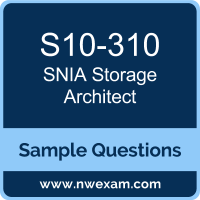01. You are asked to describe the basic financial benefits of tiered storage.What would be your description?
a) Tiered storage saves funds by only using low-cost commodity storage devices.
b) Tiered storage reduces expenses by defining a random usage structure.
c) Tiered storage only allows cost-effective auto-tiering software to migrate data from one storage tier to another based upon file type and usage pattern.
d) Tiered storage allows a user (or auto-tiering software) to store data on the most cost effective storage tier based on customer requirements.
02. A customer needs to deploy a flexible, highly available, fast storage solution to handle high I/O OLTP database applications.What should you recommend?
a) FC SAN
b) NAS
c) DAS
d) SSD JBODs
03. You need to architect a storage solution which would serve structured data from storage arrays which are at the end of a data center 100 meters away from the servers which need to access that data. Read and write access latency must be less than 1 ms.
Which type of storage access is appropriate for this solution?
a) NAS
b) IP SAN
c) FC SAN
d) DAS
04. Which statement is true for securing data in flight?
a) The protection of the confidentiality and integrity of data residing on servers, storage arrays, tape libraries, or media.
b) The securing, provisioning, monitoring, tuning, re-allocating, and controlling of the storage resources so that data may be stored and retrieved.
c) The securing of underlying/embedded systems and applications as well as integration with IT and security infrastructure.
d) The protection of the confidentiality and integrity of data as it is transferred across the storage network.
05. You need to increase the read performance on your disk array.Which caching scheme would achieve this goal?
a) read back
b) read ahead
c) read around
d) read through
06. An enterprise storage system is suspected of being the root cause for wide-spread performance degradation. The SAN environment has one director-class switch each for two redundant fabrics.
A review of the storage system does not discover any obvious problems. You have been asked to investigate the root cause. What data do you collect first?
a) storage system error logs
b) network performance data
c) server error logs
d) switch error logs
07. You are asked to build a disk array to host a read intensive, latency sensitive application.Which disks would you use in your array?
a) SATA disks (7,200 rpm)
b) SAS disks (10,000 rpm)
c) SSD
d) SAS disks (15,000 rpm)
08. A company has a data center with three tiers of disk storage. The customer wants to reduce overall storage costs yet maintain appropriate response times for various data types. You have been asked to make a recommendation to meet these needs.
What should you recommend?
a) Introduce a fourth tier with SSDs.
b) Incorporate automated tiering solution.
c) Expand the amount of Tier 2 storage.
d) Introduce compression.
09. You are asked to convert a 4-disk RAID 5 array into a 7-disk RAID 6 array. Each disk is capable of sustaining 100 MBps throughput to the host for the application.
What is the theoretical LUN performance increase between the two array configurations?
a) 200 MBps
b) 100 MBps
c) 300 MBps
d) 400 MBps
10. An enterprise data center has 137 storage arrays and 1246 hosts attached to an FC SAN. Customers complain about occasional slow performance in accessing SAN attached storage. FC switches and storage arrays logs do indicate any problem.
Which type of tool should be used to resolve this?
a) a matrix management tool
b) a historical performance management tool
c) a capacity management tool
d) a future performance management tool
 Before you write the SNIA Storage Architect (S10-310) certification exam, you may have certain doubts in your mind regarding the pattern of the test, the types of questions asked in it, the difficulty level of the questions and time required to complete the questions. These SNIA Certified Storage Architect (SCSA) sample questions and demo exam help you in removing these doubts and prepare you to take the test.
Before you write the SNIA Storage Architect (S10-310) certification exam, you may have certain doubts in your mind regarding the pattern of the test, the types of questions asked in it, the difficulty level of the questions and time required to complete the questions. These SNIA Certified Storage Architect (SCSA) sample questions and demo exam help you in removing these doubts and prepare you to take the test.